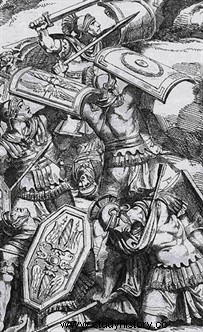 If the first name Fabien enjoyed real success during the last two decades of the 20th century, its history is much older and dates back to the early hours of Rome. From Ancient History to that of Christianity, from the French Resistance during the Second World War to the TV series of the 1980s and up to the 1998 football world cup, discover the wealth of references linked to this first name.
If the first name Fabien enjoyed real success during the last two decades of the 20th century, its history is much older and dates back to the early hours of Rome. From Ancient History to that of Christianity, from the French Resistance during the Second World War to the TV series of the 1980s and up to the 1998 football world cup, discover the wealth of references linked to this first name.
The Fabians, great figures of Roman Antiquity
Fabien is a name of Roman origin which means "bean". According to tradition, a great Roman family planted these annual leguminous plants in Rome, thus saving the city of Seven Hills from famine. This large family took its name from it:the Fabii. The Fabii claimed descent from Hercules through a daughter of Evander. Evander is a mythological hero from the origins of Rome, an Arcadian who came to settle on the Palatine Hill by bringing agriculture and writing. Admiring his great wisdom, the locals would have welcomed him as a god and took him for king. Hercules was for a time his guest, and Evander, warned by a prophecy that Hercules would be deified, was the first to worship him during his lifetime. It is therefore from the union of Hercules and the daughter of this other mythological hero that the Fabii were born.
The first historically known Fabii is Fabius Vibulanus, a Roman noble from the 6th century. From this time until the year 34 the Fabii offered to the Republic then to the Roman Empire no less than 6 dictators (extraordinary magistrate holding all the powers), 46 consuls (magistrate holding the supreme civil-military power for one year ), 6 censors (former consuls in charge of the census), 6 masters of cavalry (honorary title), 14 consular tribunes (supreme magistrates in the 5th and beginning of the 4th century) and 2 decemvirates (religious office)!
 The Fabii marked ancient history for their tragic heroism at the Battle of Crémère (477 BC ) where 306 of them, who had sworn to defend Rome, fought to the death against the army of the Veians!
The Fabii marked ancient history for their tragic heroism at the Battle of Crémère (477 BC ) where 306 of them, who had sworn to defend Rome, fought to the death against the army of the Veians!
The family was completely decimated during this disastrous fight, only little Quintus, remained in Rome due to his young age, will ensure the survival of the blood of the Fabii!
Among the descendants of the young Quintus will be found some great figures of Roman history such as Quintus Fabius Maximus Verrucosus, known as Cunctator (the Temporizer) who distinguished himself during the Punic Wars and defeated the Carthaginian army, or Quintus Fabius Pictor considered the first Roman historian!
Pope Fabian
The first name marks the history of Rome once again in 236 when a Fabian becomes Pope, against all odds... Indeed, according to tradition, Fabian is a lay Christian (that is to say without any religious profession) who was in Rome at the time when the successor of the deceased Pope Anterius was being elected. Fabien would have gone to attend the event, as a simple spectator, when a dove would have come to rest on his head... In the assembly there is amazement, the talks give way to a profound silence and all eyes directed towards the unknown... And suddenly we cheer him, "He is worthy! », and Fabien finds himself ordained Pope!
Taking advantage of a lull in the persecutions inflicted on Christians by the Roman Empire (see our article on Christians in the 3rd century), Pope Fabian would have turned out to be a very good administrator:he created seven ecclesiastical districts in Rome, led by seven deacons, he took care of the good maintenance of the catacombs where many Christians were buried... But the main action of the pontificate of Pope Fabian was to send seven missionary bishops to evangelize the Gauls! Decisions with oh so incalculable consequences! Generally considered as the apostle of the Gauls, Pope Fabien sowed Faith in Christ on the Gallic land, it will give from century to century Christian France, eldest daughter of the Church!
In 250, Pope Fabian was among the victims of the anti-Christian persecutions of Emperor Decius. Arrested, he was tortured and beheaded on January 20 on the Appian Way. Pope Fabian was canonized and his sarcophagus found in 1915.
The resistance of “Colonel Fabien”
“Colonel Fabien” is the code name taken by one of the greatest figures of the communist resistance during the Second World War:Pierre Georges (1919 – 1944).
Pierre Georges joined the French Communist Party (PCF) at the age of 14 and joined the international brigades in 1936 to fight alongside the Republicans in Spain. He became an officer, was wounded several times, suffered from pneumonia... In June 1938 he returned to France where he worked as a worker.
When in 1939 Nazi Germany and the USSR signed the German-Soviet pact Pierre Georges was interned for his communist commitments. He escaped in 1940 and carried out clandestine actions. Mounted in Paris for the Young Communists (JC), he finds himself in charge of setting up the first armed group! In 1941, he became military commissioner  of the Special Organization of the PCF, responsible for recruiting, training and supervising combatants within the JC. Pierre George himself carried out the first murderous attack against the occupier by shooting down an officer of the Kriegsmarine in the Paris metro! The attack took place on the 21st (August 1941), in reverence to the date when the invasion of the USSR by the Third Reich began (June 21, 1941). A spectacular action which marked the spirits, revealed the resistance, but which also led to repression and the disapproval of General de Gaulle who did not want an urban guerrilla in France.
of the Special Organization of the PCF, responsible for recruiting, training and supervising combatants within the JC. Pierre George himself carried out the first murderous attack against the occupier by shooting down an officer of the Kriegsmarine in the Paris metro! The attack took place on the 21st (August 1941), in reverence to the date when the invasion of the USSR by the Third Reich began (June 21, 1941). A spectacular action which marked the spirits, revealed the resistance, but which also led to repression and the disapproval of General de Gaulle who did not want an urban guerrilla in France.
In 1942, the Special Clandestine Organization of the PCF widened its recruitment and became the Francs-tireurs et partisans (FTP). Most of his companions having fallen, Pierre George left Paris for Franche-Comté and organized the maquis in the Doubs under the name of "Captain Henri". With a bounty on his head, he was denounced and arrested in October, but he managed to escape despite a head injury.
He returns to Paris but is arrested during a routine metro check in November. Beaten up at the Prefecture of Police, he is handed over to the Germans. He was interrogated and interned in Fresnes, then in Dijon where he was tried and sentenced to death.
But in 1943, having a crucial lack of manpower, the Germans commuted the executions to deportation. This gives Pierre George time to escape again!
He set out again to organize the maquis, this time in the Vosges, in Haute-Saône and in the Center and escaped the Germans thanks to the benevolence of people like Abbé Bouversse who hides and lends him a cassock and a breviary to enter Paris incognito when he needs it...
In 1944, Pierre Georges was sent to Brittany to prepare for the Allied landings, it was then that he took the pseudonym "Colonel Fabien" when he became the first FTP manager for the entire South of the Paris region. Once the Liberation of France had begun, he called for an insurrection in the capital on August 10! He carries out actions in the suburbs during which he is again injured. He manages to join the head of the column of General Leclerc's 2nd Armored Division and attacks with them the Luxembourg Palace where the Luftwaffe quarters are located.
Pierre Georges and his resistance fighters, sometimes called the "Fabians", were attached to Patton's division, then to De Lattre's army (as 151st RI).
Colonel Fabien took an active part in the Liberation of France until his death on December 27, 1944 near Mulhouse following the explosion of a mine. The exact circumstances of his death remain uncertain, it seems that he deliberately tried to manipulate the mine which accidentally exploded, killing six others and injuring nine.
 The Fabians at the end of the 20th century...
The Fabians at the end of the 20th century...
The first name Fabien came back into fashion in the 20th century through television and sports. First in 1983, Antenne 2 broadcast a successful series:“Fabien de la Drôme”. The series takes place in 1799, in the midst of the French Revolution, during the Directory. The hero, Fabien (played by Jean-François Garreaud), is an idealist supporter of Gracchus Babeuf and a member of the Conjuration of Equals which has just been destroyed by the power in place. His family having been massacred by an enigmatic "Red Boots", Fabien embarks on an adventure that touches on both the police investigation and the western in the South of France where troops of brigands, partisans of the counter-revolution, reign. war profiteers and corrupt members of the Executive Board.
Finally, many newborns are named Fabien following the 1998 football world cup. Among the favorite players of this once victorious French team was Fabien, goalkeeper with a shaved head, who in the end stopped a powerful shot from the best player in the world at the time:the Brazilian Ronaldo.
The first moments of the series "Fabien de la Drôme":
{dailymotion}x4ldkd{/dailymotion}
A must see...
• WYCKE-LECOCQ Françoise, The Fabia people in the Republican era:from legend to history. Research on the literary representation of a large Roman patrician family , (Ph.D. thesis, La Sorbonne - Paris IV, 1986, dir. Jean Beaujeu).
• GOBRY Ivan, Dictionary of the Popes, Pygmalion, 2013.
• PERRAULT Gille, BESANCENOT Olivier , GEORGES Monique, Colonel Fabien was my father, One Thousand and One Nights, 1999.
• Fabien de la Drôme:the book and the DVD.
